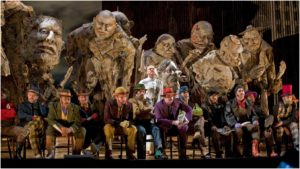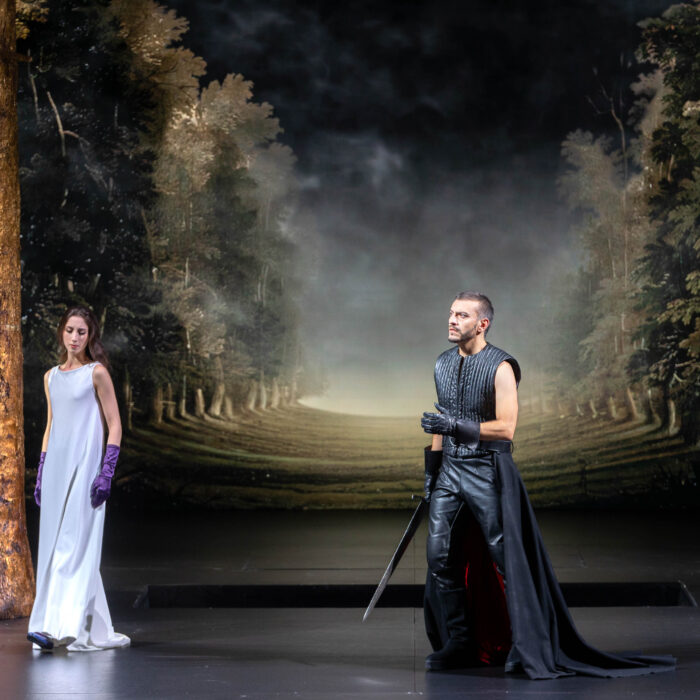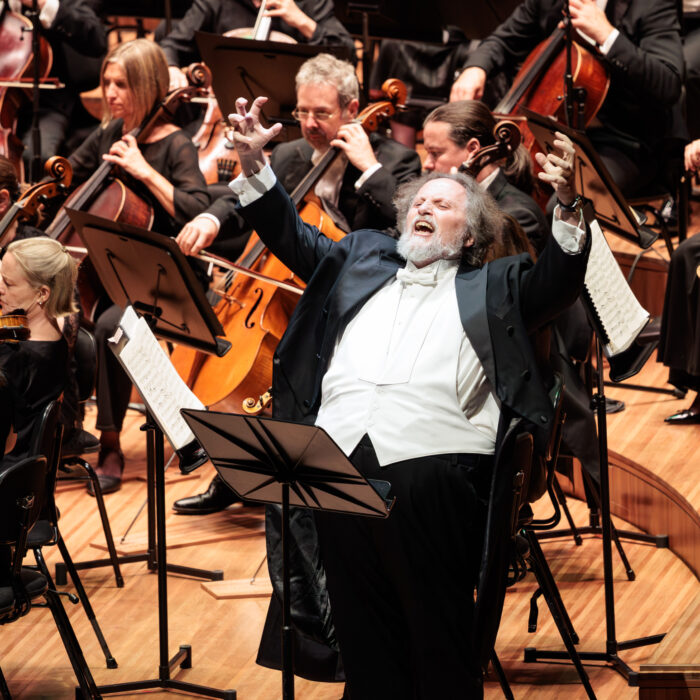
Los Angeles Opera 2018-19 Review: Satyagraha
Philip Glass’ Opera Is a Transcendent Experience About Opera’s Effect On Our Social Conscience
By Gordon WilliamsI once saw an evening of Kathakali theater, a kind of folk opera of southern India. I would probably not have understood much of what was going on in “The Killing of Dushasana” had I not read the program booklet beforehand.
Even so, after the first scene my regular biases for dialectic drama vanished and I was hooked, overwhelmed by a spectacle of simple devices – a consort of men chanting verses from the Mahabharata, dialogues in finger-language (Krishna’s choreography of mudras, which Indian neighbors told me spoke actual concepts) and elaborate costumes. I figured I was witnessing events from a legendary past to the limited extent that I could possibly hope to understand them.
I had a similar reaction to the production of “Satyagraha” which has just finished its October-November run at Dorothy Chandler Pavilion as the second offering in Los Angeles Opera’s 2018-19 season.
Philip Glass’s 1980 opera (the second in his series on historically significant men) covers the events of Mohandas K. Gandhi’s formative years in South Africa (1893-1914) when Gandhi came up with the concept of non-violent resistance which was eventually applied in his campaign to lead India to independence from British rule.
Glass’s opera also tells its story in elliptical, almost ceremonial form. It pays tribute to, rather than recounts, significant, verifiable events. And yet, more than most operas, I felt that it was exhorting me toward model behavior in the way a ceremony usually does.
Impacting The Self
This production came to Los Angeles as a re-mounting of an earlier co-production between the English National Opera and the Metropolitan Opera in collaboration with the British improvisational puppetry theater, Improbable.
To say that this production, directed by Improbable’s Phelim McDermott and associate director and scenery designer Julian Crouch, was spectacular theater is an understatement. Production stills – as useful as they are as historical record – don’t do justice to the experience of watching the way “Satyagraha’s” stage pictures unfolded, the way performers created gods, monsters and giant, threatening humans out of simple materials (such as newspaper) before our eyes.
Yet it wasn’t really until the second of this work’s three Acts that I really settled in. I had studied as widely as I could prior to attending. I read the excellent essay on the true history behind the opera in Philip Glass and librettist Constance DeJong’s “the making of” book; watched Richard Attenborough’s film with Ben Kingsley as Gandhi; read extracts from Gandhi’s autobiography. I struggled to get a sense of how an opera comprising selections in Sanskrit from India’s classic text the “Bhagavad Gita” (only sparingly surtitled), and lacking depiction of Gandhi’s major antagonists (South Africa’s General Smuts does not appear) would work for me as theater, given my own Hollywood preference for mounting conflict.
By house-lights up, however, I had come to my own understanding of “satyagraha,” which I would describe as “the force of truth alone as a weapon against violent injustice” and, taking the cue from Phelim McDermott in his program essay, I viewed the opera as a “meditative preparation” on any incarnation of Gandhi’s New Castle March (to cite Gandhi’s 1913 protest of a new tax on South Africa’s Indian residents).
At this stage of modern history, when we ask ourselves how to face attacks on truth which threaten to unbind social compacts, “Satyagraha” struck me as appropriate ceremonial preparation by which to consider our own civil involvement, and perhaps that is a response the creators would be happy with.
Perfect Complement
Of course, “Satyagraha” is an opera and its impact in the theater needs to be evaluated.
Phelim McDermott’s production was a perfect visual adjunct and complement to Glass’s score. Events moved slowly, deliberately, reverently, just as Glass’s repetitive, some still say minimalist, music might shift, slightly alter and evolve.
The upshot of this may have been to induce a meditative state, but also lay the ground for dramatic revelation in the slightest change – a shift in meter, a vocal unison, an entry, a change of costume. It was enough for example, to show Gandhi in his dhoti for us to bring to bear all we know of Gandhi and his principles. In the end, by the mere device of a spotlight falling on Gandhi (Sean Panikkar) as he turned around from a pedestal supporting Dr Martin Luther King (an incredibly disciplined David Carr miming King’s satyagrah-ist “I Have a Dream” speech in slow motion), I actually thought to myself “enlightenment.”
Incidentally, Tony Simpson’s lighting was one of the many great pleasures of this production.
Why was this production so convincing? What made the audience sit so reverently still for three and a half hours and then cheer so loudly?
It wasn’t just because Philip Glass himself came onstage to take a bow. As the curtain fell, he was still delayed by a late-arriving plane and LA traffic for all we knew.
I can’t help crediting it to the improvisational room and freedom with which McDermott and conductor Grant Gershon made this performance live. McDermott injected into this production the sort of theatrical vibrancy and quick access to responsive depth that comes from years’-long exploration of improvisational techniques.
Shaping The Line
On the most basic level we could appreciate conductor Gershon’s managerial skill in keeping this operatic experience afloat. How does anyone keep track of the repetitions in Glass’s music without the most disciplined concentration? Of course, that remark holds true for every singer onstage and every musician in the pit.
But Gershon shaped this performance beautifully I was most aware of this at the end where Gandhi repeated Krishna’s promise to regenerate himself on earth in visible form “whenever the law of righteousness withers away.” As we listened to Sean Panikkar’s golden voice rise up through the same modal phrase over and over again this was not repetition but replenishment. The length of time the long close took was the time it was meant to take. The tension held. The interest stayed aloft.
The Collective Over the Self
What must it be like to sing in such an opera? I can’t help thinking of the book that first introduced me to Minimalism – Christopher Small’s 1977 “Music, Society, Education” – and the point Small made there about Minimalism’s valuing of ensemble skills over solo display. The object in a work like “Satyagraha” must be, to large extent, to sustain the whole living structure; to make sure not to take a wrong turn. In an idealistic sense, it is an image of desirable social behavior.
This structure was amply served by a cast that included a number of Domingo-Colburn-Stein Young Artist Program alumni (So Young Park as Gandhi’s secretary Miss Schlesen and Theo Hoffman as ally, Hermann Kallenbach) alongside LA favorites such as mezzo J’Nai Bridges as Gandhi’s wife, Kasturbai, and bass Morris Robinson as Gandhi’s mentor, Parsi Rustomji.
Ensembles such as the trio honoring the value of honest work between the three women (Kasturbai, Miss Schlesen and Domingo-Colburn-Stein member Erica Petrocelli as Mrs Naidoo) and the Act two Scene two quintet where So Young Park’s top notes (up to a high C#) continually rose over the texture like sunlight touching a swift-turning globe were musical events to savor. A good deal of the value of this “Satyagraha” was the aural beauty of the overall effect.
And yet, shining out, as he was meant to do, Sean Panikkar (whose experience extends even to appearances on “America’s Got Talent”) was incredibly convincing as Gandhi. We could bask in the fullness and rich core of his tone while his mere stage presence conveyed power and humility – and the power of humility.
This was an event that made me wonder about the social importance of opera beyond mere entertainment. Some years ago I drove out to Ipolera Outstation in Central Australia seeking permission from a senior man to incorporate some traditional sacred song in an opera production. On the way out I asked my friend Baydon how he was going to explain opera to his uncle. He said, “I’m going to tell him that it’s white man’s ndapa” (using a term for the secular public form of life-sustaining ritual).
“Satyagraha” strikes me as a prime example of this.


